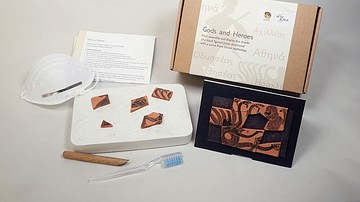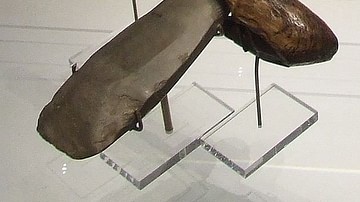Review

| Rating: | |
|---|---|
| Title: | A History of the World in 100 Objects |
| Author: | Neil MacGregor |
| Audience: | General Public |
| Difficulty: | Easy |
| Publisher: | Penguin Books |
| Published: | 2013 |
| Pages: | 736 |
Originally a series of BBC radio broadcasts, A History of the World in 100 Objects explores objects from prehistory through 2010 CE, including a 2-million-year-old chopping tool, a Welsh gold cape, a mummy coffin, a seated Buddha from Pakistan, and the double-headed Aztec serpent on the book cover. Former director of the British Museum Neil MacGregor engages readers with witty, concise writing that illuminates the intersecting stories of each object with a diverse crowd of experts.
When you visit a museum, you probably skip a few exhibits - some broken pottery shards here, a tiny scrap of paper there. But even the most ordinary looking object can be fascinating in the company of an expert guide. So it is with A History of the World in 100 Objects, where Neil MacGregor, former director of the British Museum, discusses 100 objects drawn from the British Museum's vast collection, which, incidentally, includes seemingly ordinary objects such as broken pottery shards (from a Tanzanian beach at the heart of a major trade hub) and a tiny scrap of paper (a pharaoh's sandal label that emanates military might).
How can MacGregor claim to cover all of world history in one tome? To be clear, he makes no such claim. As the title says, MacGregor is telling "a" history of the world, not "the" history. The book can be appreciated for what it is - a selective, but incredibly diverse range of objects from all over the world (Greece, Yemen, China) and social classes (workers, merchants, emperors). The 100 objects are explained in 100 small chapters arranged into 20 themes. Two-thirds of the objects predate the 17th century CE; approximately 50 are ancient or classical - a treasure trove for ancient history fans.
MacGregor devotes only one or two glossy color photos and a few pages per object but always presents an engrossing narrative demonstrating that each object lies at the intersection of multiple socioeconomic, military, and religious developments. Each chapter also incorporates welcome input from one or more experts, including historians, religious leaders, archaeologists, writers, and government officials. Yet the book is easy, enjoyable reading. MacGregor himself is alternately humorous, affectionate, somber, and always erudite. Of the Rosetta Stone, MacGregor humorously quips that it is "decidedly dull to look at — a grey stone about the size of one of those large suitcases you see people trundling around on wheels at airports" (209). But, like many objects in museums, the Rosetta Stone has more to it than meets the eye - MacGregor notes it features not three languages (as commonly stated), but four - an English soldier wrote on it after Napoleon's forces in Egypt surrendered it, over 2,000 years after the Rosetta Stone was created.
The book contains several minor errors. For example, regarding the Lachish Reliefs, MacGregor asserts that the Bible "understandably glosses over the disagreeable fact" that Assyrian ruler Sennacherib seized the cities of Judah until its king, Hezekiah, "was crushed, gave in, and paid up" (134). But the Bible does not gloss over it at all - 2 Kings 18:9-16 states that Hezekiah lost Samaria and then "all the fortified cities of Judah" to the Assyrians, then paid silver and gold to Sennacherib. The book also contains controversial objects (the Warren Cup), and controversial experts (Boris Johnson of Brexit infamy), but these do not detract from the book's many successes.
Few books reveal our past with such gusto. Highly recommended.
About the Reviewer
Cite This Work
APA Style
Chay, J. (2019, May 10). A History of the World in 100 Objects. World History Encyclopedia. Retrieved from https://www.worldhistory.org/review/212/a-history-of-the-world-in-100-objects/
Chicago Style
Chay, Justin. "A History of the World in 100 Objects." World History Encyclopedia. Last modified May 10, 2019. https://www.worldhistory.org/review/212/a-history-of-the-world-in-100-objects/.
MLA Style
Chay, Justin. "A History of the World in 100 Objects." World History Encyclopedia. World History Encyclopedia, 10 May 2019, https://www.worldhistory.org/review/212/a-history-of-the-world-in-100-objects/. Web. 30 Jun 2025.




